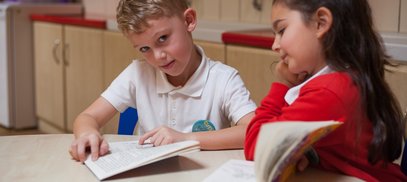We're delighted to share with you our latest blog in our series, Library Lifeline, written in association with the School Library Association. This series is designed to support anyone working in a school library by answering their questions directly. If you have a question that you’d like to ask our ‘agony aunt’ – the SLA’s Member Development Librarian, Dawn Woods – then please email us at worldofstories@literacytrust.org.uk and your question may be the focus of a future blog!
This week's question comes from a teacher who wants to learn more about situation books.
Can you explain what Situation books are and how useful it is to stock them in my library and classroom?
Situation books are those titles which cover real-life themes that can help children understand various real-life situations. You may also know those titles which are specifically designed to work through different issues with children as ‘social stories’.
Situation books are a valuable learning tool as well as a means for pupils to understand sometimes confusing or complex situations taking place in their lives or in the lives of others. We highly recommend displaying them in your school’s prominent reading spaces such as the library and class book corners.
Why use situation books?
When we, as adults, approach a new situation we often read up about it. Off on holiday? Read about where you are going. Do they drive on the same side of the road? What currency is in use? Thinking about applying for a new job? Read about the company. Read about what they do. It gives us reassurance we will know what to expect, what we’ll be doing.
Exactly the same applies for children, the difference being that it’s our responsibility to prepare our children for new situations. The good news is that there are fantastic titles available for most of these occasions.
For instance, in The New Small Person by Lauren Child or in It’s Big Brother Time! by Nandini Ahuja, a child can understand that a new sibling will bring fun but also sometimes impatience and jealousy, and this can reassure the older sibling.
Seeing what happens in playgroup or school in Lucy Cousins’ Maisie Goes to Nursery, will help ease the transition and anxieties. Even for older children reading Jacqueline Woodson’s illustrated The Day You Begin, about starting new adventures may help in the transition from primary to secondary.
Sunday Rain by Rosie J Pova, about a boy who moves house and is too afraid to make new friends, is a fantastic way to encourage children to open up to new friendships in different settings, and Mira’s Curly Hair by Maryam Al Serkal is a celebration about natural hair and about how the courage to be yourself can be so rewarding even in the face of wanting to look like ‘everyone else’.
How to use situation books
Teachers and librarians can read with pupils in read-along time or on a one-to-one basis to help them prepare. Books offer a structure that can be helpful when talking about particular situations or emotions. You can allow time for questions which may even include pupils voicing their worries about the approaching situation, and that way dispel their fears.
Make these books available to carers and parents so that if necessary, such as in the case of an illness or bereavement the book is shared on a one-to-one basis with close role models who may also need guidance in broaching difficult topics.
As school staff, knowing about some of the key titles available means that you can refer to them in your more informal book chat with pupils, thus highlighting and generating interest in them. Non-fiction situation books will also appeal to those who love reading non-fiction and learning about different social environments for enjoyment.
Books also offer comfort for children who read alone when they are experiencing a situation they feel they can’t talk about to an adult. Having books available in the school library gives pupils the independence to choose a title which can help them enormously. If they are experiencing bullying not all children will ‘tell’. They try to manage the situation themselves. That often involves giving into the bully, or hiding, or at the other extreme confronting the bully physically themselves. But books will offer an insight into possibly why that bully feels the need to intimidate.
Empathy insights and practical effects
With the empathy insights this gives the reader they can then try other strategies to tackle the situation. It may still not be the complete answer but may help. Situation books are a safe way to help with an environment a pupil may find themselves in.
Sometimes it may be appropriate to read in a class situation. A class member has been in hospital with a serious illness, so a book about how they may be feeling and their worries about their future or how their classmates will treat them on return will help raise empathy levels so the class is sensitive to their feelings.
In severe, even dangerous cases, fiction and non-fiction books about domestic violence develop a story problem which is resolved by the child telling a trusted adult. For some children living through these challenges, the appropriate book may even serve as a suitable signpost or offer healthy coping strategies. Pupils can read the protagonists’ stories, identify with them and know the situation is not their fault.
Further information
Even if you think no one will have written a book on any particular situation you’d be surprised.
These reputable sites offer age-appropriate, well sourced book lists and resources which are a fantastic starting point:
